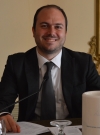
Contributions
Abstract: EP1034
Type: E-Poster Presentation
Session title: Myeloma and other monoclonal gammopathies - Clinical
Background
Bendamustine is an old bi-functional alkylating agent which has proved to be effective in relapsed, refractory and in new diagnosed Multiple Myeloma (MM).
Aims
Thus, aiming to provide further insights in this field, also in novel agents’era, we present here a retrospective, real-life analysis of patients with relapsed/refractory MM (rrMM), who had received salvage therapy with bendamustine in combination with bortezomib and dexamethasone (BVD)
Methods
81 patients (44 M/37 F), with rrMM, median age at diagnosis 59.4 years (r. 36-82), median age at start of treatment 63.6 years (r.37-86) treated with several lines of treatments (median 6, r. 2-11), every refractory to all the drugs previously received (also Bortezomib), received BVD (B 90 mg/sqm days 1,2; V 1.3 mg/sqm days 1,4,8,11, D 20 mg days 1,2,4,5,8,9,11,12, Pegfilgrastim day +4) every 28 days, until progression.
All patients had previously received bortezomib-based and IMIDs-based treatments, and 32% (26/81) had also received radiotherapy. 69% (56/81) had undergone single or double autologous and three (2%) allogeneic stem cell transplant. All patients were relapsed and refractory to last therapies received before BVD.
Results
Bendamustine was well tolerated, with grade 3-4 transfusion-dependent anemia in 56% (46/81) of patients, and 43% (35/81) grade 3-4 neutropenia (no ospedalization was required, no septic shocks were observed). No severe extrahematologic toxicity was observed, only grade 1 gastrointestinal side effect (nausea), treated by common antiemetic drugs.
According to IMWG, ORR was 63% (51/81: 7 CR, 18 VGPR, 15 PR, 11 MR) with 11 PD and 19 patients in SD, which can be considered as an impressive result in this subset of rrMM patients. In particular, for 11 patients, BVD was, after having achieved at least a PR, a bridge to second auSCT, and for two patients a bridge to alloSCT. Eight patients have surprisingly achieved a notable PR after failure of novel agents (i.e. Carfilzomib, Daratumumab and Pomalidomide).
Median time to response was 1.3 months (r.1-3), median OS from diagnosis was 67.3 months (r.6-151), median OS from start of Bendamustine was 9.6 months (r.2-36).
Conclusion
The triplet Bendamustine-Bortezomib-Dexamethasone has shown significant efficacy in a particularly severe setting of patients, relapsed and refractory to all available therapeutic resources, and, in particular cases, it could be considered as a bridge to a second autologous or allogenic SCT, also after failure of novel agents.
Keyword(s): Bendamustine, Myeloma, Relapse
Abstract: EP1034
Type: E-Poster Presentation
Session title: Myeloma and other monoclonal gammopathies - Clinical
Background
Bendamustine is an old bi-functional alkylating agent which has proved to be effective in relapsed, refractory and in new diagnosed Multiple Myeloma (MM).
Aims
Thus, aiming to provide further insights in this field, also in novel agents’era, we present here a retrospective, real-life analysis of patients with relapsed/refractory MM (rrMM), who had received salvage therapy with bendamustine in combination with bortezomib and dexamethasone (BVD)
Methods
81 patients (44 M/37 F), with rrMM, median age at diagnosis 59.4 years (r. 36-82), median age at start of treatment 63.6 years (r.37-86) treated with several lines of treatments (median 6, r. 2-11), every refractory to all the drugs previously received (also Bortezomib), received BVD (B 90 mg/sqm days 1,2; V 1.3 mg/sqm days 1,4,8,11, D 20 mg days 1,2,4,5,8,9,11,12, Pegfilgrastim day +4) every 28 days, until progression.
All patients had previously received bortezomib-based and IMIDs-based treatments, and 32% (26/81) had also received radiotherapy. 69% (56/81) had undergone single or double autologous and three (2%) allogeneic stem cell transplant. All patients were relapsed and refractory to last therapies received before BVD.
Results
Bendamustine was well tolerated, with grade 3-4 transfusion-dependent anemia in 56% (46/81) of patients, and 43% (35/81) grade 3-4 neutropenia (no ospedalization was required, no septic shocks were observed). No severe extrahematologic toxicity was observed, only grade 1 gastrointestinal side effect (nausea), treated by common antiemetic drugs.
According to IMWG, ORR was 63% (51/81: 7 CR, 18 VGPR, 15 PR, 11 MR) with 11 PD and 19 patients in SD, which can be considered as an impressive result in this subset of rrMM patients. In particular, for 11 patients, BVD was, after having achieved at least a PR, a bridge to second auSCT, and for two patients a bridge to alloSCT. Eight patients have surprisingly achieved a notable PR after failure of novel agents (i.e. Carfilzomib, Daratumumab and Pomalidomide).
Median time to response was 1.3 months (r.1-3), median OS from diagnosis was 67.3 months (r.6-151), median OS from start of Bendamustine was 9.6 months (r.2-36).
Conclusion
The triplet Bendamustine-Bortezomib-Dexamethasone has shown significant efficacy in a particularly severe setting of patients, relapsed and refractory to all available therapeutic resources, and, in particular cases, it could be considered as a bridge to a second autologous or allogenic SCT, also after failure of novel agents.
Keyword(s): Bendamustine, Myeloma, Relapse


